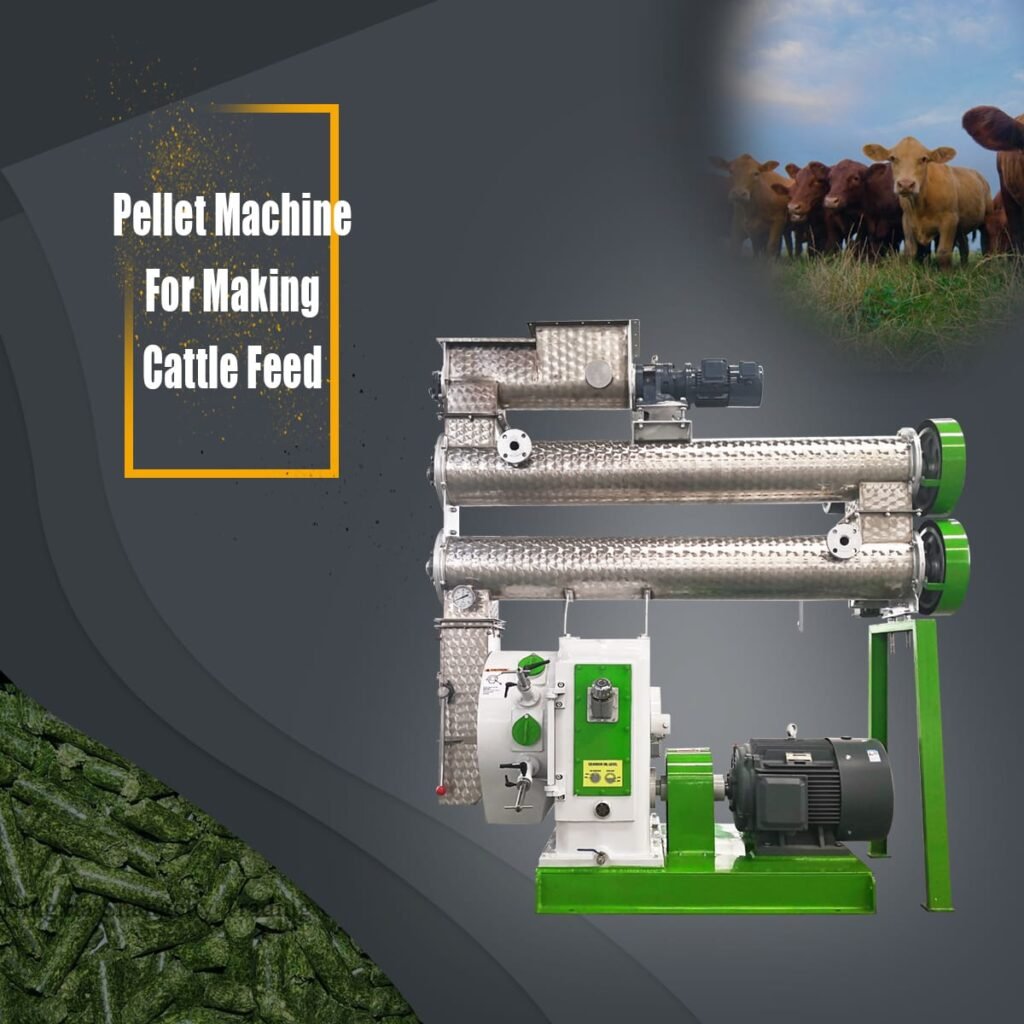In the competitive and expanding cattle industry, ensuring a consistent supply of high-quality, nutritionally balanced feed is essential for optimizing animal health, growth, and productivity. The investment in a 10 T/H cattle feed manufacturing machine represents a significant step towards achieving efficient and cost-effective feed production. Here’s a comprehensive overview of the price considerations and overall costs associated with these machines:
Significance of Cattle Feed Manufacturing Machines
Cattle feed manufacturing machines are pivotal for:
- Consistent Product Quality: Utilizing advanced technologies to produce feed pellets with precise nutrient profiles, supporting optimal cattle health and performance.
- Efficient Production: Offering an output capacity of 10 tons per hour, these machines cater to large-scale operations, ensuring cost-effectiveness and meeting demand.
- Customized Formulations: Tailoring feed formulations to meet specific nutritional requirements of different cattle breeds, life stages, and production systems, thereby enhancing productivity.
- Sustainability: Integrating sustainable practices such as alternative protein sources and energy-efficient technologies, aligning with environmental responsibility.
- Economic Opportunities: Generating employment, stimulating local economies, and fostering growth within the cattle sector.
Understanding the Price of 10 T/H Cattle Feed Manufacturing Machines
The 10 T/H cattle feed manufacturing machine price varies based on several factors:
- Machine Configuration: Includes components like grinders, mixers, pellet mills, coolers, and automation systems, influencing overall cost.
- Brand and Manufacturer: Established brands may command a premium due to reputation and quality assurance.
- Automation and Control Systems: Higher levels of automation and sophisticated control systems contribute to increased costs but offer enhanced efficiency.
- Additional Features and Customizations: Specialized features and customizations (e.g., material handling, dust collection, safety features) add to the machine’s price.
- Geographic Location: Factors in transportation costs, import duties, and local taxes from the manufacturer to the delivery destination.
Based on current data, the price range for a basic configuration 10 T/H cattle feed manufacturing line can vary widely, typically ranging from $150,000 to $300,000 USD. It’s important to note that specific requirements, additional features, and customizations can significantly impact the final price.
Factoring in the Overall Cost of Cattle Feed Manufacturing
Beyond the initial machine purchase, establishing and operating a cattle feed manufacturing facility entails additional costs:
- Land and Site Preparation: Includes land acquisition, grading, drainage, and infrastructure development.
- Building and Infrastructure: Construction of production facilities, storage areas, offices, and supporting infrastructure.
- Auxiliary Systems: Implementation of material handling, dust collection, process control systems, and utilities.
- Permits and Regulatory Compliance: Costs for obtaining necessary permits, licenses, and ensuring compliance with feed safety and environmental standards.
- Raw Materials: Ongoing procurement of grains, oilseeds, protein sources, vitamins, and minerals.
- Labor and Personnel: Salaries, wages, and benefits for operators, maintenance staff, quality control personnel, and administrative roles.
- Energy and Utilities: Expenses related to electricity, water, and other utilities essential for operations.
- Maintenance and Repairs: Regular upkeep of machinery, equipment, and infrastructure to sustain optimal performance.
- Transportation and Logistics: Costs associated with transporting raw materials and distributing finished products.
- Overhead and Administrative Costs: General operational expenses and management overhead.
The 1-40 T/H cattle feed manufacturing plant cost typically ranges from $10,000 to $850,000 USD, contingent upon capacity and specific facility requirements. These costs are subject to variation based on factors such as location, raw material availability, and technological integration.
Related post: fully automatic cattle feed plant
Maximizing the Value of Investment
To optimize return on investment in a 10 T/H cattle feed manufacturing machine, consider these strategies:
- Market Research: Assess market demand and raw material availability to validate investment feasibility.
- Energy Efficiency and Sustainability: Prioritize machines with sustainable features to reduce long-term operational costs and environmental impact.
- Financing Options: Explore leasing or financing to manage upfront costs effectively.
- Supply Chain Reliability: Establish robust supply chains for raw materials and product distribution.
- Skilled Workforce: Invest in training for optimal machine operation and maintenance.
- Continuous Improvement: Embrace a culture of ongoing process enhancement and technology adoption.
- Diversification: Explore product diversification or alternative applications to expand market reach.
By strategically evaluating these factors and implementing prudent investment strategies, stakeholders can make informed decisions when acquiring a 10 T/H cattle feed manufacturing machine. This approach not only maximizes investment value but also contributes to the sustainable growth and efficiency of the cattle industry globally.

